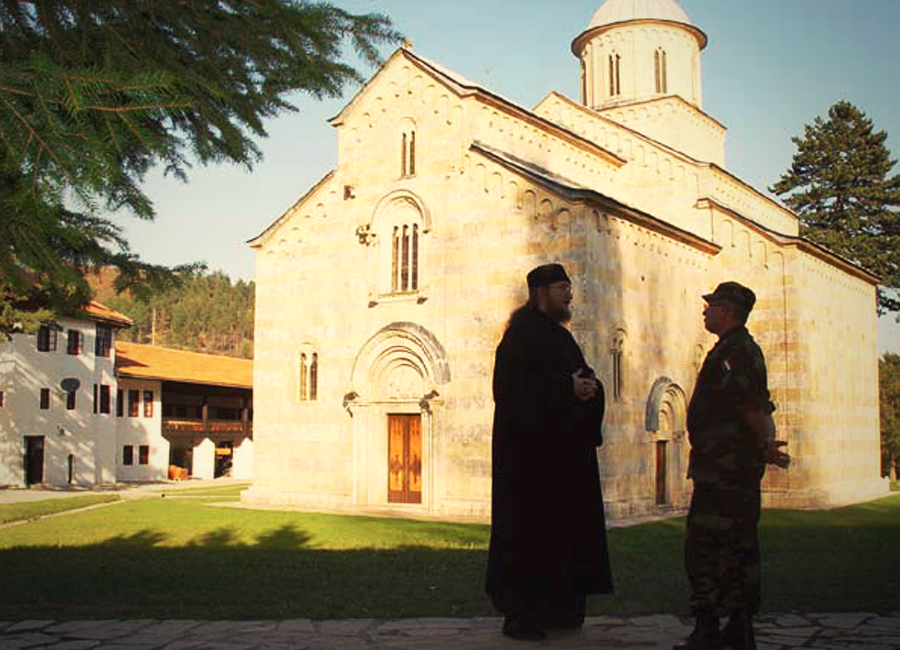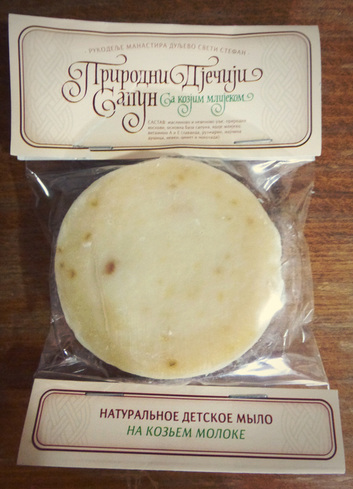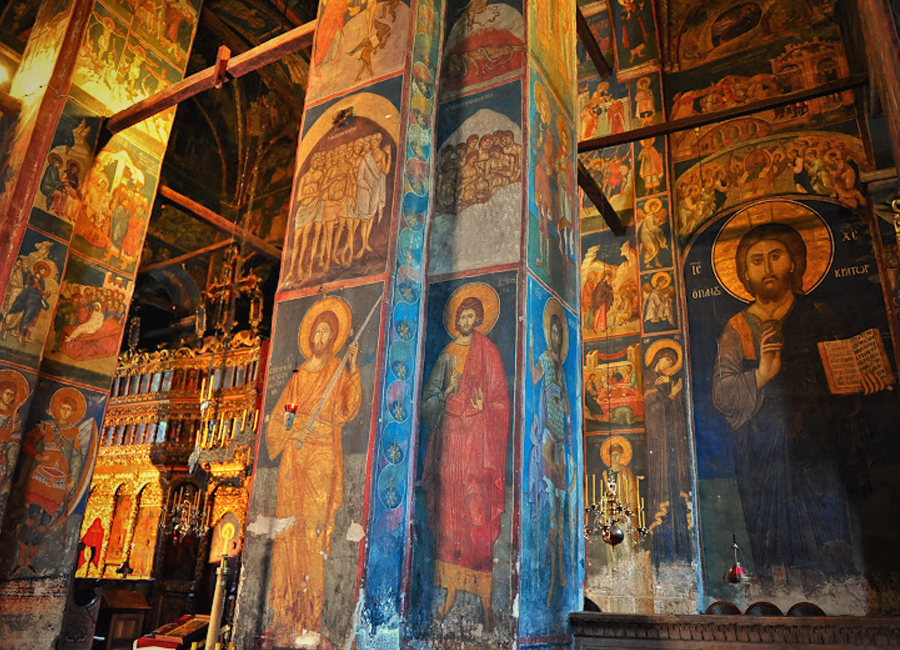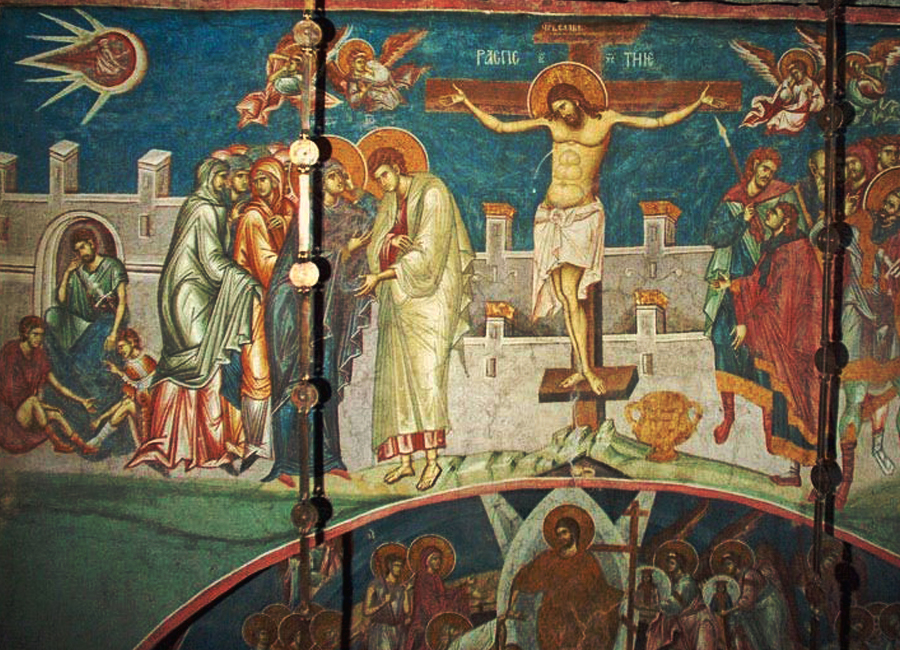|
Two worlds of war and peace are forced together in Western Kosovo where a 700-year old Serbian Orthodox Christian monastery quietly nestles amongst chestnut groves in a mountain valley. The approaching road displays evidence that racial tensions still exist here- Serbian Latin writing on every road sign has been scrawled over with paint. We were heading for Deçan not Dečani. This was the first religious site we have visited where we had to drive through checkpoints, around roadblocks and submit our passports to gun-wielding military before entering. Visoki Decani Monastery has been described as "the largest and best-preserved medieval church in the entire Balkans" with several thousand Byzantine frescoes adorning the interior walls. The paintings took 6 groups of artists ten years to complete and cover an area of 4,000m2. 25 monks live within its heavily guarded walls, although the last direct attack was grenades in 2007, the threat of ethnic violence remains.
I have never seen Andy’s jaw drop as it did as we entered the church, stepping across the original marble floor at the foot of angular, stone columns. The frescoes greet you like a window from the past, where several thousand Byzantine paintings depicting 1,000 portraits of Saints stare silently from all sides. Their intricate, colourful detail cover almost the entire interior of the church. Uniquely, the religious depictions include the only existing image of Jesus with a sword, Petar clarified “this is a spiritual sword, representing the Word of God, in which the sword is cutting sins”. Nearby, on the ‘Crucifixion’ fresco we noticed what many people believe to be two UFO’s with men inside. “Not so” Petar smiled “in Byzantine iconography, these two ’comets’ represent the sun and the moon, and a man inside is the personification of the heavenly body of the sun and moon” We felt incredibly privileged to have such a personal, knowledgeable insight. “Can you identify all of the frescoes inside here?” I asked him “After 13 years… almost” he replied humbly. The Monastery was established in 1327 under the instruction of Serbian Medieval King St. Stephen of Decani. The monastery is both his life’s work and his mausoleum; his 684 year-old body remains in a coffin at the head of the altar. Petar informed us that 10 years after his funeral, the body of St Stephen was found intact in his grave, perfectly preserved and undecomposed, with a sweet smell which exists until today. “We do nothing to preserve the body, it is forbidden in the Orthodox Church to do anything with a human body after death- we don’t even know any technique to do it! We have no interest to preserve the body, because this is not an important factor when considering someone as Holy”. Petar explained “The body is still whole and fragrant, even when constantly exposed to air and kissing. We believe this is because God’s energies are still present in it.” Every Thursday, the coffin is opened to allow worshippers to show respect, say prayers and offer Thanks to St Stephen. Petar invited us to join them for this service in 5 days but, with people awaiting our arrival in Montenegro, we regrettably declined the offer. We were however, fortunate enough to accept his invitation to join them for their evening worship.
The feeling that so much had changed outside of these walls in the last 700 years, yet inside the marble walls the rituals, words and music were untouched by time. The candlelight flickered the walls, making the gold tinged frescoes glimmer- our eyes were seeing exactly what worshipers saw 700 years previously. The heavy smoke swung from incense thuribles. Ceremonial devotion frozen in time.
I asked Petar what he hoped for the future of the Monastery; “We hope it will survive because it is under God’s protection. He has preserved the Monastery during seven centuries under very difficult circumstances. We are determined to stay and live here no matter what happens, trying to have love also with our enemies”.
2 Comments
Anne Smart
21/1/2015 01:36:41 am
A very moving account of your visit. Thank you.
Reply
Alex
22/1/2015 06:14:57 am
It is on of the most important Serbian shrines and crown's gem of Serbian Cultural Heritage under UNESCO protection. I really enjoy talking with father Peter and of course testing excellent red wine made by monks (app 5€ per bottle).
Reply
Your comment will be posted after it is approved.
Leave a Reply. |
Archives
July 2020
Categories
All
|
Proudly powered by Weebly





 RSS Feed
RSS Feed